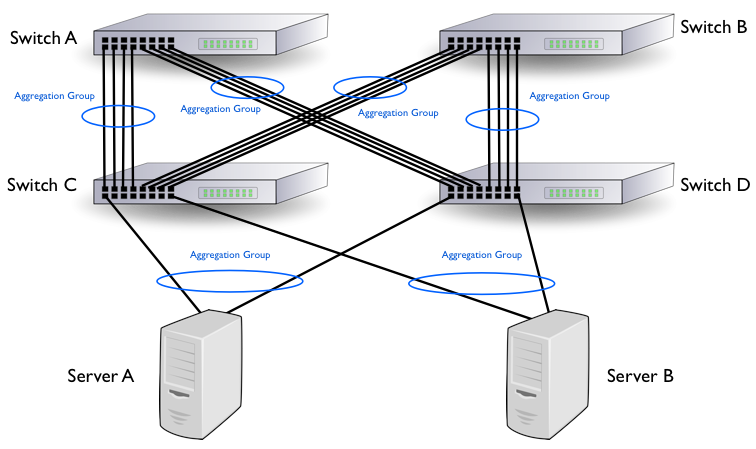lacp,lacp demo,lacp costs,lacp tests
SPOTO offers 100% real & valid Cisco, PMP, ISACA, AWS, and other IT exam dumps to help you pass IT
exams. We will list out lacp tips, lacp demo, lacp tutorial, lacp cost, lacp latest industry news, all things you
concern about the Certification online proctored exam.
-
- 1842
- SPOTO
- 2024-06-19 17:21
lacp,lacp demo,lacp costs,lacp tests
SPOTO offers 100% real & valid Cisco, PMP, ISACA, AWS, and other IT exam dumps to help you pass IT
exams. We will list out lacp tips, lacp demo, lacp tutorial, lacp cost, lacp latest industry news, all things you
concern about the Certification online proctored exam.
-
- 1842
- SPOTO
- 2024-06-19 17:21
Link aggregation is a crucial concept in modern networking, allowing for the bundling of multiple physical links to form a single logical link. This approach enhances bandwidth, redundancy, and reliability. Chapter 4 of the "CCIE Routing and Switching v5.0 Official Cert Guide, Volume 1" provides in-depth insights into link aggregation and its implementation in Cisco networks. This blog post will explore the key technical terms and concepts associated with link aggregation, enabling readers to grasp the fundamentals and advanced features of this technology. What is Link Aggregation? Link aggregation, also known as Ethernet bonding or NIC teaming, is the process of combining multiple network connections in parallel to increase throughput and provide redundancy. This technology is standardized by the IEEE under the 802.3ad specification, also known as Link Aggregation Control Protocol (LACP). Key Benefits of Link Aggregation: Increased Bandwidth: By aggregating multiple links, the total bandwidth available is the sum of the individual link speeds. Redundancy: If one link in the aggregation fails, traffic can still be carried by the remaining links, ensuring continuous network availability. Load Balancing: Traffic is distributed across all links in the aggregation, improving overall network performance and preventing congestion on a single link. Link Aggregation Control Protocol (LACP) LACP is a part of the IEEE 802.3ad standard that provides a dynamic method for aggregating multiple physical ports. It allows switches to negotiate and manage the aggregation of links automatically. Key Features of LACP: Dynamic Link Aggregation: LACP can dynamically add or remove links from the aggregation based on the availability and operational state of the links. Port Priority: LACP allows setting port priorities to determine which links should be preferred for aggregation and which should be used as backups. LACPDU: Link Aggregation Control Protocol Data Units (LACPDUs) are exchanged between devices to manage the state of the link aggregation. Configuring Link Aggregation on Cisco Devices Configuring link aggregation on Cisco devices involves creating EtherChannel interfaces, which bundle multiple physical interfaces into a single logical interface. There are two primary protocols used for link aggregation on Cisco devices: LACP and Cisco's proprietary Port Aggregation Protocol (PAgP). Basic Configuration Steps: Create an EtherChannel Interface: interface Port-channel1 Add Physical Interfaces to the EtherChannel: interface range GigabitEthernet0/1 - 2 channel-group 1 mode active # For LACP Verify Configuration: show etherchannel summary Port Aggregation Protocol (PAgP) PAgP is a Cisco proprietary protocol used for the automatic creation of EtherChannels. Like LACP, PAgP helps manage the grouping of physical interfaces into a single logical interface but is only compatible with Cisco devices. Key Features of PAgP: Modes of Operation: PAgP supports different modes such as desirable and auto, which control how interfaces initiate and respond to aggregation requests. Compatibility Checks: PAgP ensures that all ports in the aggregation have compatible configurations and capabilities before forming an EtherChannel. EtherChannel Load Balancing EtherChannel supports various load-balancing methods to distribute traffic across the member links. These methods can be based on different criteria such as source and destination MAC addresses, IP addresses, or TCP/UDP ports. Common Load Balancing Methods: src-mac: Balances traffic based on the source MAC address. dst-mac: Balances traffic based on the destination MAC address. src-dst-mac: Balances traffic based on a combination of source and destination MAC addresses. src-ip: Balances traffic based on the source IP address. dst-ip: Balances traffic based on the destination IP address. src-dst-ip: Balances traffic based on a combination of source and destination IP addresses. Troubleshooting Link Aggregation Effective troubleshooting is critical to maintaining optimal performance and reliability of link aggregation. Common issues include misconfigured ports, incompatible settings, and hardware failures. Key Troubleshooting Commands: show etherchannel summary: Provides an overview of EtherChannel status and member interfaces. show interfaces port-channel: Displays detailed information about the EtherChannel interface. debug etherchannel: Offers real-time debugging information for EtherChannel operations. Advanced Link Aggregation Features Cisco devices support advanced features to enhance the functionality and flexibility of link aggregation: VSS (Virtual Switching System): Concept: VSS combines two physical Cisco Catalyst switches into a single logical switch, enabling unified management and operation. Benefits: Simplifies network design, increases redundancy, and improves bandwidth utilization by leveraging link aggregation across the combined switch. vPC (Virtual Port Channel): Concept: vPC allows a pair of Cisco Nexus switches to appear as a single logical switch to connected devices, enabling link aggregation across both switches. Benefits: Provides high availability and redundancy while simplifying the network topology. Link aggregation is a powerful technique in network engineering that enhances bandwidth, redundancy, and reliability by combining multiple physical links into a single logical link. Understanding the principles of LACP, PAgP, and EtherChannel configuration on Cisco devices is essential for optimizing network performance and ensuring robust connectivity. Advanced features like VSS and vPC further expand the capabilities of link aggregation, making it a vital component in modern network infrastructures. By mastering these concepts, network engineers can design and manage scalable, efficient, and resilient networks, ensuring seamless data flow and uninterrupted connectivity in diverse and demanding environments.
